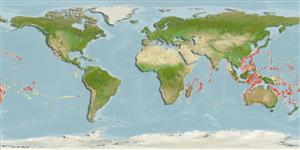>
Gadiformes (Cods) >
Macrouridae (Grenadiers or rattails)
Etymology: Nezumia: A Japanese word that means "mouse".
More on authors: Gilbert & Cramer.
Environment: milieu / climate zone / depth range / distribution range
Ecología
marino bentopelágico; no migratorio; rango de profundidad 219 - 914 m (Ref. 58302). Deep-water; 30°N - 35°S, 34°E - 85°W (Ref. 1371)
Indo-Pacific: off Mozambique, Kyushu-Palau Ridge, and Hawaii. Southeast Pacific: Sala y Gomez Ridge. Very close to Nezumia condylura.
Tamaño / Peso / Age
Maturity: Lm ? range ? - ? cm
Max length : 27.0 cm TL macho / no sexado; (Ref. 1371)
Espinas dorsales (total) : 2; Radios blandos dorsales (total) : 160 - 163; Espinas anales: 0. Snout short, blunt, with large terminal and lateral angle scutes; underside of the snout, mandible and most of the suborbital, and part of the lower margin of the preopercle without scales. Pyloric caeca 22 to 32. Body scales with sharp, needle-like spinules arranged in parallel rows. Overall color is brownish, abdominal region violaceous; gill membranes blackish; fins dusky, first dorsal fin blackish distally. Also Ref. 2800.
A benthic species found on the continental slope (Ref. 75154). Off Hawaii, individuals reportedly taken in June by the ALBATROSS had been feeding exclusively on small eggs. Mature eggs were found in a specimen taken in August (Ref. 1690).
Life cycle and mating behavior
Madurez | Reproducción | Puesta | Huevos | Fecundidad | Larva
Cohen, D.M., T. Inada, T. Iwamoto and N. Scialabba, 1990. FAO species catalogue. Vol. 10. Gadiform fishes of the world (Order Gadiformes). An annotated and illustrated catalogue of cods, hakes, grenadiers and other gadiform fishes known to date. FAO Fish. Synop. 125(10). Rome: FAO. 442 p. (Ref. 1371)
IUCN Red List Status (Ref. 130435: Version 2024-1)
Threat to humans
Harmless
Human uses
Pesquerías: pesquerías de subsistencia
Herramientas
Special reports
Download XML
Fuentes de Internet
Estimates based on models
Preferred temperature (Ref.
123201): 7.9 - 13.8, mean 10.1 °C (based on 323 cells).
Phylogenetic diversity index (Ref.
82804): PD
50 = 0.5000 [Uniqueness, from 0.5 = low to 2.0 = high].
Bayesian length-weight: a=0.00214 (0.00109 - 0.00421), b=3.20 (3.03 - 3.37), in cm total length, based on LWR estimates for this (Sub)family-body shape (Ref.
93245).
Nivel trófico (Ref.
69278): 3.3 ±0.1 se; based on size and trophs of closest relatives
Resiliencia (Ref.
120179): Medio, población duplicada en un tiempo mínimo de 1.4-4.4 años (Preliminary K or Fecundity.).
Fishing Vulnerability (Ref.
59153): Low vulnerability (17 of 100).
